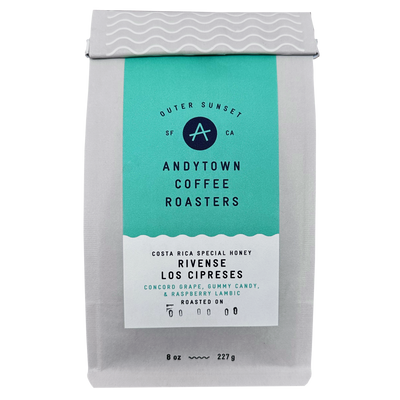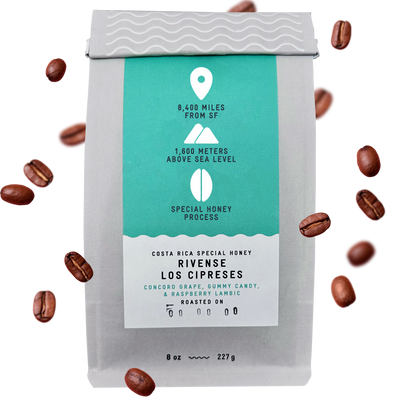When it comes to showcasing honey-processed coffees, we’ve often leaned on our friends at Café Rivense del Chirripó in Costa Rica. Over the years, we’ve tried samples from different farmers who work with Café Rivense, but we’re always drawn back to coffees from the Los Cipreses Farm. It’s owned and managed by the same folks who founded the Café Rivense Micromill, the Ureña-Rojas family.
 Corazon and Michael meeting with Tati and Ricardo of Café Rivense at the Specialty Coffee Expo in Houston 2025
Corazon and Michael meeting with Tati and Ricardo of Café Rivense at the Specialty Coffee Expo in Houston 2025
In the honey process, cherry skins are removed from ripe, red coffee cherries before they are placed on drying beds. There are varying degrees of the honey process, and their names correspond to the colors coffees turn into once dry: white, yellow, red, and black (or full honey). White honey has the least amount of mucilage left intact, while black honey retains all of the mucilage. As the coffees begin to dry, the mucilage gets sticky like honey and the coffees start to clump. To ensure even drying and prevent defects, the coffees need to be closely monitored and rotated regularly. This processing method accentuates sweetness and a syrupy body, and can also enhance acidity.
![]()
 Don Regulo Ureña is raking honey coffees to promote even drying.
Don Regulo Ureña is raking honey coffees to promote even drying.
You might remember that last year, we featured the black honey from Los Cipreses. The lot we are highlighting this year from Los Cipreses is one of our favorite experimental coffees and undergoes two fermentation processes. The first fermentation step started with the black honey process, and the coffees were partially dried for 4-5 days on raised beds. In the second fermentation, the coffees were placed in sealed bags to create a low-oxygen environment and stored in the shade for 2-3 days. In the final step, the coffee finished drying in mechanical dryers for approximately 48 hours.
 A view of the mechanical dryer from the top.
A view of the mechanical dryer from the top.
I’ve once said that this coffee is loud and unapologetic, much like European summer nightclubs by the beach. That was a few years ago. With the processing method refined over the past several years, it’s like this coffee has aged, becoming less loud, more sophisticated, yet still unapologetic in its presence. I don’t normally favor wild flavors in the morning, but surprisingly, I’ve found myself wanting to brew this coffee as my first cup of the day. I see and taste purple when I drink this coffee: concord grapes, gummy candy, and raspberry lambic dominate the cup.
There’s a precise tension and balance between fruitiness, sweetness, and booziness that makes this coffee alluring.
This coffee is also excellent iced. If you serve it in a rocks glass with some large ice cubes and an orange slice for a garnish, you’ve got a caffeinated, non-alcoholic mocktail. Whether you’re a traditionalist or an adventure seeker, the Special Honey Los Cipreses is certain to incite colorful conversation on what coffee is, and what it can be!
COSTA RICA SPECIAL HONEY RIVENSE LOS CIPRESES
Concord Grape, Gummy Candy, & Raspberry Lambic Starting at $15.75One of our favorite experimental coffees is back to impress our adventurous aficionados. For this...
Shop Now



